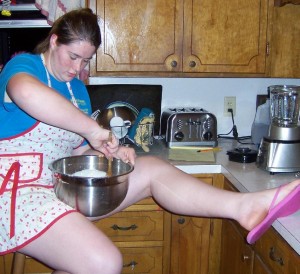 Dimensional Analysis
Dimensional Analysis
This important math process is one of the important skills that
Dimensional Analysis
A math skill that is not just for those preparing for science careers. It is an every day skill–it can even make cooking easier.
Partly because of her dimensional analysis skills, the cook shown “zipped” through her college science courses. Her chemistry knowledge helps when she doesn’t have the ingredients a recipe calls for. For example, she knows that sweet milk soured with an acid, such as lemon juice can be used if buttermilk is not available. But her dimensional analysis skills give her the confidence to have a relaxed attitude because she determined her measurements before she started–note the pen and yellow pad in the background. (FYI: The cook is Mrs. Lauren Russell Theiss, my granddaughter who just for fun started learning chemistry when she was 10. Don’t all grannies entertain visiting grandchildren with chemistry experiments?)Following are two basic dimensional analysis examples:
Example 1
If a recipe calls for 10 mL of oil, how many teaspoons of oil would you add?
Think!
1. Write the conversion equation that compares the units of milliliters and teaspoons, like this: 5 mL = 1 teaspoon
2. Write an equation for your problem, like this: 10 mL = ? teaspoons
FACT: Notice the line under the equation. This line is important. Any unit below the line cancels out the same unit above the line. Also, any number below the line is divided into one of the number above the line.
3. Use the conversion equation to cancel out the milliliter (mL) unit and replace it with the teaspoon unit.
10mL x 1 teaspoon = ? teaspoons
5 mL
4. Next, the number 10 above the line is divided by 5, which is below the line. The quotient will be 2.
5. Next multiply all the numbers above the line to determine the magnitude of the answer.
2 x 1 = 2
6. Next multiply all the units above the line to determine the measuring unit(s) for the answer.
Since there is only one unit, which is teaspoon, then the answer unit will be teaspoon(s).
Answer: 10 mL = 2 teaspoons
Example 2
Check to see if the answer in the previous problem is correct. Do this by taking the answer and writing a problem, such as: Using dimensional analysis, determine how many mL 2 teaspoons is equal to.
Think!
1. You will use the same procedure, so first write the conversion equation that compares the units of milliliters and teaspoons, like this:
5 mL = 1 teaspoon
2. Write an equation for your problem, like this: 2 teaspoons = ? mL
3. Use the conversion equation to cancel out the teaspoon unit and replace it with the milliliter (mL) unit. Notice that the conversion equation is written like a fraction as before, but in reverse–meaning the numbers and their units have are in opposite places. Before the 1 teaspoon measurement was above the line and in this problem it is above the line. Also, the 5 mL measurement is above the line in this problem and below the line in the previous problem.
4. So how do you know where to put the measurments? The measuring units give you the answer. In this problem, teaspoons is above the line, so the number of teaspoons from the conversion equation must be below the line.
5. The answer must be in mL, so the number of milliliters from the conversion equation must be above the line.
2 teaspoon X 5 mL = ? mL
1 teaspoon
6. Next, the number 2 above the line is multiplied by 5, which is also above the line. The product is 10.
7. Next multiply all the units above the line to determine the measuring unit(s) for the answer.
Since there is only one unit, which is mL, the answer unit will be mL.
Answer: 2 teaspoons = 10 mL